Conference Presentations by Chryssa Vergidou
3rd International Congress on Archaeological Sciences in the Eastern Mediterranean and the Middle East (ICAS-EMME 3) 14-18 March 2022 The Cyprus Institute, Nicosia, Cyprus, 2022
Rescue excavations (1999-2001) at the site of Vrysi in Pontokomi (Kozani, Western Macedonia, Gree... more Rescue excavations (1999-2001) at the site of Vrysi in Pontokomi (Kozani, Western Macedonia, Greece) have brought to light 101 burials (mostly single inhumations in pit graves) of a Roman times burial site dated from the 1 rst to the 4 th c. AD (Karamitrou-Mentesidi, 2002). The area where the burial site was found is semi-mountainous and in Roman times belonged to the fourth administrative republic of Macedonia Provincia, a region according to the epigraphic record, populated by a more or less homogenous population (Sverkos, 2000). From mortuary data known from the Graeco-Roman world in general (Toynbee, 1971), we can infer that there burials were used by the lowest strata of the respective society.
SYMPOZJUM EGEJSKIE 8TH CONFERENCE IN AEGEAN ARCHAEOLOGY University of Warsaw, Poland June 23rd–25th, 2021 (online), 2021
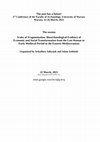
The past has a future! The session Scales of Fragmentation: Bioarchaeological Evidence of Economic and Social Transformation from the Late Roman to Early Medieval Period in the Eastern Mediterranean Organized by Arkadiusz Sołtysiak and Adam Izdebski, 2021
This presentation briefly outlines ongoing bioarchaeological research conducted at The Science an... more This presentation briefly outlines ongoing bioarchaeological research conducted at The Science and Technology in Archaeology and Culture Research Centre (STARC) of The Cyprus Institute, focused on Eastern Mediterranean/ Near Eastern assemblages dating between 300-800 CE. Our research interests generally span prehistory to 18th century CE populations, aiming at elucidating diachronically patterns of health and disease, diet, mobility and overall life quality. At the moment, three projects in our research team cover part of the SCALoFRAG time span, namely the study of skeletal remains from 7th century CE Amathus (Cyprus), the Roman Province of Macedonia (Greece), as well as Roman Tyre, Beirut and Byblos (Lebanon). The research questions fall under the abovementioned broad scope of bioarchaeological research in STARC; however, they are context-specific for each assemblage. As such, for Amathus, the emphasis is on identifying bioarchaeological changes between the era before and after the Arab invasions, for Greece we test dietary patterns and the degree to which they may offer insights to the character ‘Romanization’ acquired in different regions, while for Lebanon, we examine the relative ‘status’ of the population in three Phoenician cities, which had diverse economies, also within the broader context of ‘Romanization’. These projects involve various partners, with most notable the national departments/ephorates of antiquities; however, we are always keen to expand our collaborative network, especially among other institutions that actively engage in bioarchaeological research in the region.
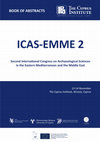
2nd International Congress on Archaeological Sciences in the Eastern Mediterranean and the Middle East (ICAS-EMME 2) 12-14 November 2019 The Cyprus Institute, Nicosia, Cyprus, 2019
We are delighted to welcome you to the 2 nd International Congress on Archaeological Sciences in ... more We are delighted to welcome you to the 2 nd International Congress on Archaeological Sciences in the Eastern Mediterranean and Middle East, or ICAS-EMME 2 for short. We are proud to host nearly 100 presentations on a wide range of topics, ranging from Art Characterization to the use of Synchrotrons, from Crops, Foods and Landscapes to Human Osteoarchaeology, and from Archaeological Materials to Digital Archaeology and Computation in Archaeology. Within this, we treat the term 'Archaeology' very broadly -a lot of studies address historical and cultural aspects more than strictly archaeological work. But this is one of the strengths and characteristics of ICAS-EMME: the ability to cross borders, to combine innovation in methods with original research questions, to break out from the strict disciplinary focus and to offer more comprehensive views on the lives and times of people past, regardless of whether the evidence we study and discover emerges from the soil through excavation, or has been kept above ground.
https://www.geschkult.fu-berlin.de/e/aegyptologie/termine/Annual-Meeting-Necropoleis_20191.html
Research introductions by Chryssa Vergidou
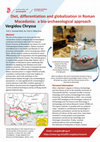
The aim of my project is to carry out the first comparative study to integrate bio-archaeological... more The aim of my project is to carry out the first comparative study to integrate bio-archaeological, contextual and textual data from the Imperial Roman Province of Macedonia, by means of a multimethodological dietary analysis. Dietary variation and differences in the health and lifestyle of two provincial communities, and of social groups within them, will be used as a proxy to reconstruct social differentiation and incorporation into the globalizing networks of the Roman Empire. The ultimate goal is to explore how people living under Roman rule in the Province of Macedonia were redefining their identities by adopting new lifestyles and novel mortuary practices. This study is innovative because it will make use of different methodologies for dietary reconstruction in a region hitherto virtually unstudied, it will provide crucial new insights on archaeo-diet, and it will contribute to the Romanization debate through a bio-archaeological perspective. It is also significant for archaeological science because it will offer a holistic approach in past dietary reconstruction by integrating different current analytical techniques and by verifying results against historical data.
TMA62, 2020
PhD research (University of Groningen and STARC - The Cyprus Institute)
Talks by Chryssa Vergidou
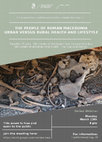
The Roman Empire was a remarkably diverse and multiethnic state, characterized by intensified int... more The Roman Empire was a remarkably diverse and multiethnic state, characterized by intensified interaction and increased mobility among the heterogeneous groups of people who comprised its population. Within this highly interconnected world, diverse political, socioeconomic, cultural and environmental tensions were at play leading to the development of new social identities and structures, but also to a change in people’s living standards. Being at the interface of the social and biological sciences, the discipline of bioarchaeology has substantially contributed to our understanding of past life experiences through the contextual study of the human skeleton. Available osteological data from the Roman period suggest variations in health and lifestyle among the diverse groups of people being gradually incorporated to the constantly expanding empire. Under this framework, we examine two archaeological populations from the Roman Province of Macedonia (Greece), a hitherto understudied region and period. The first, comes from the necropolis of the city of Dion, the Macedonian’s religious center and federal shrine, that became a colony in 32/31 BC. The second, was unearthed at the site of Pontokomi-Vrysi a semi-mountainous and remote from the main networks of trade and communication rural site located to the westernmost provincial administrative district of Upper Macedonia. In this talk, we would like to present the preliminary results of our ongoing analyses. We will focus specifically on variation in skeletal and dental diseases used as proxies for health, everyday life, diet and socioeconomic status by carrying out a comparison between an urban, highly connected center and a rural inland community. Capita Selecta/Research Seminar Monday March 15th, 2021, Groningen Institute of Archaeology.
Papers by Chryssa Vergidou
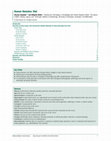
Encyclopedia of Archaeology, 2nd Edition, 2023
The reconstruction of past dietary patterns holds a central place in bioarchaeology given the imp... more The reconstruction of past dietary patterns holds a central place in bioarchaeology given the importance of food
consumption for daily subsistence and survival but also for forging social bonds. Several analytical methods have been
developed for this purpose: macroscopic, microscopic, chemical and biomolecular. This entry focuses on some of the key
osteoarchaeological methods employed in the study of past diet, that is, dental diseases associated with excessive
consumption or lack of macro- and micronutrients, as well as dental macro- and microwear, which offer information
regarding food processing practices. In addition, very brief reference is made to pathological conditions linked to dietary
deficiencies. The potential and limitations of each method are discussed, and representative case studies from a global context
are presented to showcase both the use of the methods presented in this entry as well as their complementarity with other
approaches.
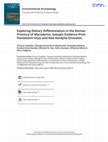
Environmental Archaeology: The Journal of Human Palaeoecology , 2023
This paper used stable isotope analysis (δ 13 C and δ 15 N) to examine whether intra-and inter-si... more This paper used stable isotope analysis (δ 13 C and δ 15 N) to examine whether intra-and inter-site sex and age differences existed within two distinct communities of Roman Macedonia in relation to the dietary preferences of their inhabitants. It also explored the degree of influence that the micro-ecology characterising the sub-region each community used to reside and the social status of these individuals had in determining the observed dietary profiles. The results showed no sex and age intra-community differences, but did reveal important inter-site differences. Together these observed patterns have implications regarding the way archaeologists and more specifically bioarchaeologists still examine social groups in relation to food; oversimplified divisions on inequalities in the household domain need to be reconsidered, or at least justified. They also show the potential bioarchaeology holds to enlighten aspects of the social history of the 'common' people residing in the provinces. It lastly argues for the potential of science-based approaches to the study of food to provide supplementary information regarding past dietary preferences that can be used as a proxy to detect variable degrees of incorporation into the globalising networks of the Roman world and argues for a closer collaboration between bioarchaeology and current theoretical discussions on Romanization.
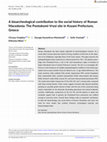
International Journal of Osteoarcheology, 2022
Roman Macedonia has been largely neglected by bioarcheological research. As a result, little is k... more Roman Macedonia has been largely neglected by bioarcheological research. As a result, little is known about the imprint of living conditions of that time on the skeletons of its inhabitants, especially those of the lower classes. This paper presents the paleopathological study conducted on a Roman period (1st-4th c. CE) skeletal assemblage from Pontokomi-Vrysi, a site in the semi-mountainous region of Eordaea in Upper Macedonia (now in Kozani Prefecture, Greece). The aim is to investigate differences in the frequency of multiple paleopathological conditions in the buried population and to assess whether these are linked to sex-or age-related differences. The study examines cribra orbitalia (CO), porotic hyperostosis (PH), enamel hypoplasia (EH), osteoarthritis (OA), vertebral osteoarthritis (VOA), intervertebral disk disease (IDD), Schmorl's nodes (SNs), trauma (Tr), and lower limb periostitis/periostosis (PO). The results show higher frequencies of OA, IDD, PO, and Tr among males compared with those among females. These results suggest increased male physical hardship, pointing to a possible gender division of labor with the men of the community being mostly responsible for the physically demanding agricultural and animal husbandry activities. Additionally, comparisons of the CO, PH, and EH patterns in adults and nonadults support that, in general, the Pontokomi-Vrysi community was resilient enough to overcome stress. Overall, these findings make an important contribution to both the bioarcheology and social history of Roman Macedonia and stress the need for more studies that combine historical, archeological (cultural), and bioarcheological data.
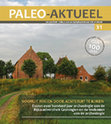
Paleo-aktueel, 2021
Pronkjewails in distant places: Mortuary studies in the eastern Mediterranean by the GIA. The Gre... more Pronkjewails in distant places: Mortuary studies in the eastern Mediterranean by the GIA. The Greek Archaeology research group of the GIA specializes in mortuary archaeology, studying sites in the eastern Mediterranean and Middle East that date from the Bronze Age through to the Late Roman period. Our methodology includes theoretical approaches; cemetery excavations; the analysis of legacy data; studies of grave architecture, tombstones and grave goods; osteological analyses; digitization of datasets and digital applications; and DNA analysis, as well as isotopic and biomolecular studies, and we are focused on performing integrated studies with thorough contextual analyses. Our central question is how people dealt with death and what their funerary remains tell us about their lives and their world. Together with our local and international network of researchers and laboratories, our staff and students aim to perform innovative research, reach out to the public, and provide diverse ...
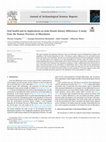
Journal of Archaeological Science: Reports, 2021
This paper examines the permanent dentition of sixty-one individuals from the Pontokomi-Vrysi Rom... more This paper examines the permanent dentition of sixty-one individuals from the Pontokomi-Vrysi Roman rural population of the Provincia Macedonia (1st-4th c. CE) aiming to explore differences in the oral health between males and females of the assemblage. All teeth were macroscopically examined for dental pathologies and dental wear, and observations were compared at an intra-assemblage level, between males and females, as well as against published data from two Roman-Italian and two Graeco-Roman sites. Results show a homogenous pattern in the oral health of the Pontokomi-Vrysi population, pointing to a rather undifferentiated diet between the two sexes, characterized mainly by the consumption of carbohydrates and to a lesser extent by the supplementary intake of protein-deriving food sources. Comparison of the results with those from the other Greek and Italian sites reveals complex oral health and dietary profiles for these populations. This paper suggests caution when universal oral health and dietary patterns for the inhabitants of the Roman Empire are sought.
Conference Sessions (Call for papers) by Chryssa Vergidou

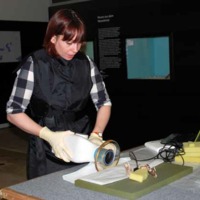
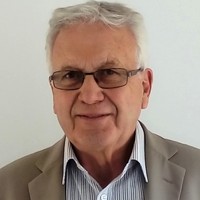

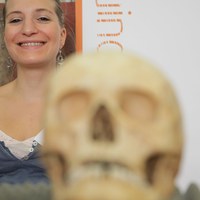
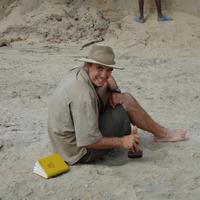




Uploads
Conference Presentations by Chryssa Vergidou
Research introductions by Chryssa Vergidou
Talks by Chryssa Vergidou
Papers by Chryssa Vergidou
consumption for daily subsistence and survival but also for forging social bonds. Several analytical methods have been
developed for this purpose: macroscopic, microscopic, chemical and biomolecular. This entry focuses on some of the key
osteoarchaeological methods employed in the study of past diet, that is, dental diseases associated with excessive
consumption or lack of macro- and micronutrients, as well as dental macro- and microwear, which offer information
regarding food processing practices. In addition, very brief reference is made to pathological conditions linked to dietary
deficiencies. The potential and limitations of each method are discussed, and representative case studies from a global context
are presented to showcase both the use of the methods presented in this entry as well as their complementarity with other
approaches.
Conference Sessions (Call for papers) by Chryssa Vergidou
consumption for daily subsistence and survival but also for forging social bonds. Several analytical methods have been
developed for this purpose: macroscopic, microscopic, chemical and biomolecular. This entry focuses on some of the key
osteoarchaeological methods employed in the study of past diet, that is, dental diseases associated with excessive
consumption or lack of macro- and micronutrients, as well as dental macro- and microwear, which offer information
regarding food processing practices. In addition, very brief reference is made to pathological conditions linked to dietary
deficiencies. The potential and limitations of each method are discussed, and representative case studies from a global context
are presented to showcase both the use of the methods presented in this entry as well as their complementarity with other
approaches.